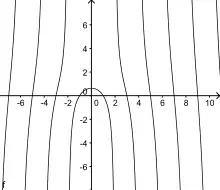Quadratrix
In geometry, a quadratrix (from Latin quadrator 'squarer') is a curve having ordinates which are a measure of the area (or quadrature) of another curve. The two most famous curves of this class are those of Dinostratus and E. W. Tschirnhaus, which are both related to the circle.
Quadratrix of Dinostratus
The quadratrix of Dinostratus (also called the quadratrix of Hippias) was well known to the ancient Greek geometers, and is mentioned by Proclus, who ascribes the invention of the curve to a contemporary of Socrates, probably Hippias of Elis. Dinostratus, a Greek geometer and disciple of Plato, discussed the curve, and showed how it effected a mechanical solution of squaring the circle. Pappus, in his Collections, treats its history, and gives two methods by which it can be generated.
- Let a helix be drawn on a right circular cylinder; a screw surface is then obtained by drawing lines from every point of this spiral perpendicular to its axis. The orthogonal projection of a section of this surface by a plane containing one of the perpendiculars and inclined to the axis is the quadratrix.
- A right cylinder having for its base an Archimedean spiral is intersected by a right circular cone which has the generating line of the cylinder passing through the initial point of the spiral for its axis. From every point of the curve of intersection, perpendiculars are drawn to the axis. Any plane section of the screw (plectoidal of Pappus) surface so obtained is the quadratrix.

Another construction is as follows. DAB is a quadrant in which the line DA and the arc DB are divided into the same number of equal parts. Radii are drawn from the centre of the quadrant to the points of division of the arc, and these radii are intersected by the lines drawn parallel to AB and through the corresponding points on the radius DA. The locus of these intersections is the quadratrix.

Letting A be the origin of the Cartesian coordinate system, D be the point (a, 0), a units from the origin along the x-axis, and B be the point (0, a), a units from the origin along the y-axis, the curve itself can be expressed by the equation[1]
Because the cotangent function is invariant under negation of its argument, and has a simple pole at each multiple of π, the quadratrix has reflection symmetry across the y-axis, and similarly has a pole for each value of x of the form x = 2na, for integer values of n, except at x = 0 where the pole in the cotangent is canceled by the factor of x in the formula for the quadratrix. These poles partition the curve into a central portion flanked by infinite branches. The point where the curve crosses the y-axis has y = 2a/π; therefore, if it were possible to accurately construct the curve, one could construct a line segment whose length is a rational multiple of 1/π, leading to a solution of the classical problem of squaring the circle. Since this is impossible with compass and straightedge, the quadratrix in turn cannot be constructed with compass and straightedge. An accurate construction of the quadratrix would also allow the solution of two other classical problems known to be impossible with compass and straightedge: doubling the cube and trisecting an angle.
Quadratrix of Tschirnhaus

Hippias quadratrix (dotted)
The quadratrix of Tschirnhaus[2] is constructed by dividing the arc and radius of a quadrant in the same number of equal parts as before. The mutual intersections of the lines drawn from the points of division of the arc parallel to DA, and the lines drawn parallel to AB through the points of division of DA, are points on the quadratrix. The Cartesian equation is . The curve is periodic, and cuts the x-axis at the points , being an integer; the maximum values of are . Its properties are similar to those of the quadratrix of Dinostratus.
Other quadratrices
Other curves that have historically been used to square the circle include:
- Archimedean spiral
- Ozanam's quadratrix
- Cochleoid
References
- This article incorporates text from a publication now in the public domain: Chisholm, Hugh, ed. (1911). "Quadratrix". Encyclopædia Britannica. Vol. 22 (11th ed.). Cambridge University Press. p. 706.
- "Dinostratus quadratrix", Encyclopedia of Mathematics, EMS Press, 2001 [1994]
- See definition and drawing in the following online source: Hutton C. (1815). A Philosophical and Mathematical Dictionary Containing... Memoirs of the Lives and Writings of the Most Eminent Authors. Vol. 2. London. pp. 271–272.
External links
- Quadratrix of Hippias Archived 2012-02-04 at the Wayback Machine at the MacTutor archive.
- Hippias' Quadratrix at Convergence (MAA periodical)